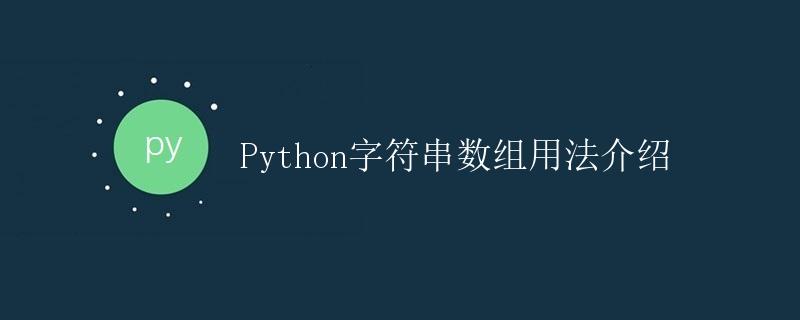Python字符串数组用法介绍

1. 字符串数组的定义与初始化
在 Python 中,字符串数组可以用列表(List)来表示。列表是一种有序、可变的数据类型,其中的元素可以是任意类型的数据,包括字符串。
我们可以通过以下方式初始化一个字符串数组:
str_array = ['apple', 'banana', 'orange', 'grape', 'kiwi']
或者使用 list() 函数将其他的可迭代对象转化为列表:
str_array = list(('apple', 'banana', 'orange', 'grape', 'kiwi'))
2. 字符串数组的访问
与其他类型的数组类似,我们可以通过索引来访问字符串数组中的元素。Python 中的索引是从 0 开始的,即第一个元素的索引是 0,第二个元素的索引是 1,依次类推。
示例代码如下:
str_array = ['apple', 'banana', 'orange', 'grape', 'kiwi']
print(str_array[0]) # 输出:'apple'
print(str_array[2]) # 输出:'orange'
print(str_array[-1]) # 输出:'kiwi',负数索引表示从末尾开始计数
3. 字符串数组的切片
在 Python 中,我们可以使用切片(Slice)来获取字符串数组的一部分。切片操作通过指定起始索引和结束索引来实现,语法格式为 [start:end],其中 start 表示起始索引,end 表示结束索引,不包含结束索引对应的元素。
示例代码如下:
str_array = ['apple', 'banana', 'orange', 'grape', 'kiwi']
print(str_array[1:4]) # 输出:['banana', 'orange', 'grape']
print(str_array[:3]) # 输出:['apple', 'banana', 'orange'],默认起始索引为 0
print(str_array[2:]) # 输出:['orange', 'grape', 'kiwi'],默认结束索引为最后一个元素的索引加一
4. 字符串数组的长度
我们可以使用 len() 函数获取字符串数组的长度,即数组中元素的个数。
示例代码如下:
str_array = ['apple', 'banana', 'orange', 'grape', 'kiwi']
print(len(str_array)) # 输出:5
5. 字符串数组的遍历
遍历字符串数组是一种常见的操作,可以使用循环来逐个访问数组中的元素。
示例代码如下:
str_array = ['apple', 'banana', 'orange', 'grape', 'kiwi']
for fruit in str_array:
print(fruit)
输出为:
apple
banana
orange
grape
kiwi
6. 示例代码及运行结果
以下是更多示例代码及其运行结果,帮助理解字符串数组的用法:
示例 1: 反转字符串数组
str_array = ['apple', 'banana', 'orange', 'grape', 'kiwi']
reversed_array = str_array[::-1]
print(reversed_array)
输出为:
['kiwi', 'grape', 'orange', 'banana', 'apple']
示例 2: 合并字符串数组
str_array1 = ['apple', 'banana', 'orange']
str_array2 = ['grape', 'kiwi']
combined_array = str_array1 + str_array2
print(combined_array)
输出为:
['apple', 'banana', 'orange', 'grape', 'kiwi']
示例 3: 使用 join() 方法连接字符串数组
str_array = ['apple', 'banana', 'orange', 'grape', 'kiwi']
delimiter = ', '
combined_str = delimiter.join(str_array)
print(combined_str)
输出为:
apple, banana, orange, grape, kiwi
示例 4: 替换字符串数组中的元素
str_array = ['apple', 'banana', 'orange', 'grape', 'kiwi']
replaced_array = [fruit.replace('a', 'X') for fruit in str_array]
print(replaced_array)
输出为:
['Xpple', 'bXnXnX', 'orXnge', 'grXpe', 'kiwi']
示例 5: 检查字符串数组中是否存在特定字符串
str_array = ['apple', 'banana', 'orange', 'grape', 'kiwi']
target = 'orange'
if target in str_array:
print(target + ' exists in the array.')
else:
print(target + ' does not exist in the array.')
输出为:
orange exists in the array.
通过以上示例代码,我们可以更好地理解和运用 Python 字符串数组的相关操作。
总结:
通过本文对 Python 字符串数组的定义、初始化、访问、切片、长度获取、遍历等方面进行了详细介绍,并给出了示例代码及其运行结果,希望能帮助读者更好地理解和运用这一数据结构。在实际应用中,根据具体需求,可以综合运用字符串数组的各种操作,实现更为复杂的功能。
 极客教程
极客教程